Rachel Neumeier's Blog, page 288
October 25, 2016
Cavalier spaniels everywhere!
I don’t have time for a real post, so here’s some pictures from the Annual Cavalier Fall Festival at my place last Sunday:

A dog participates in the Pumpkin Pie Eating Contest

The one non-Cavalier gets a lot of attention

Making friends

My contribution to the potluck, in honor of Halloween

The photographer manages to get all my dogs more or less posed
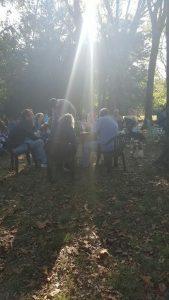
Sun going down on the festival

Sleepy puppy after a long day at the festival
Please Feel Free to Share:









October 24, 2016
Recent Reading: Clash of Eagles by Alan Smale
The Romans meet the Cahokian mound builders, in a particularly imaginative alternate history. (Where do authors get their ideas? I ask myself that roughly as often as any non-author, probably.)
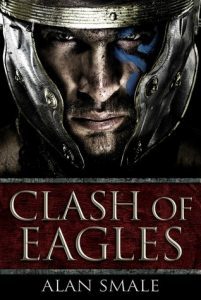
It’s 1218 AD, according to the calendar of the Christ-Risen. It’s 1,972 years since Rome was founded. In this world, it never fell. The Roman Empire today controls everything from the Norsemen of Scandinavia to Britain to all of Europe, then south to Sub-Saharan Africa and all the way east to the Ganges River. So. That’s Rome.
Rome’s having trouble expanding eastward, though, what with the Mongols and Turks. So isn’t it lucky they’ve discovered a new continent? New Hesperia promises new lands and heaps of gold. What Roman Emperor could resist? So here’s the 33rd Legion, under the command of Gaius Marcellinus, landing in the bay called Chesapica and marching west, west, ever west, cutting their arrow-straight road through the endless forest and building a small town every evening. The Iroqua pick off the odd Roman soldier, but mostly just stay out of their way.
And then there’s Cahokia. You know, there’s no proof the Cahokians didn’t have hang-gliders. No one actually knows much about the Cahokians or the mound-builder society in general, and after all the components of hang-gliders wouldn’t last terribly well.
Well, Alan Smale had to do something to make the Cahokians a match for a Roman legion, right? And he might as well pick something really fun while he was at it, right? So, hang-gliders. Also another little innovation that I don’t want to give away, but that plausibly allows the Cahokians to defeat the Romans in double quick time during their first meeting.
Now, since I grew up in St Louis, I’m pretty familiar with Cahokia. I don’t know how many school trips took us out there, but more than a coupld. I’m really pleased to see Cahokia front-and-center in an alternate history, because it was quite something. The city and immediate environs probably had a population of 20,000 or so, which is certainly not peanuts. The biggest mound is 1000 square feet at the base and 100 feet high, overlooking a carefully leveled grand plaza of about 50 acres, the whole surrounded by a two-mile palisade. Smale includes appendices about this stuff for the interested reader, so I didn’t have to stop and look up the numbers for any of that.
But this isn’t a history. It’s a historical novel, with plenty of action and lots of great characters, starting with Marcellinus. Now, I do think possibly Marcellinus is a little too good to be true. Still, I had no trouble rooting for him as the story unrolled. He (and the Cahokians, once he’s drawn into their society) certainly have major obstacles to overcome. Even with all Marcellinus can teach the Cahokians about metallurgy and tactics, they don’t have everything their own way. In fact, let me just mention, Marcellinus in particular is in kind of a tight spot at the end of this book. It’s not quite a cliffhanger of an ending, but it leans that way.
On the other hand, the second book, Eagle in Exile came out this year and the third is due out in 2017, so not too much waiting involved.
If you’re a fan of alternate history, or if you like historicals generally, you really should give this one a try. The writing is good, the characterization is good, the setting is fabulous, and while I wouldn’t believe in just every detail about the hang-gliders without running them past somebody better at physics than I am, they are a wildly entertaining worldbuilding item. I won’t be waiting long before starting the second book, and I’m sure I’ll be waiting impatiently for the third.
Please Feel Free to Share:









October 21, 2016
On not quite belonging
Here’s a thoughtful post from Bibliotropic about being an ex-pat (She’s British and living in Canada):
That’s the thing about being an ex-pat, I suppose. It’s so easy to feel like you have two homes and yet none. That you’re torn between heritage and upbringing, that anything you remember about before just holds you back from adapting to now, even when you’ve been out of that “before” place for decades. Assimilate or flounder, and oh, by the way, you’ll never really assimilate. At best, you’ll pass. If nobody looks too closely. And nobody questions why you’re using the wrong country’s term for something.
It’s worth reading the whole thing, and worth keeping in mind if in your writing you have a protagonist move from one country to another, like Trei in The Floating Islands We see that situation in fantasy pretty often, it seems to me.
Please Feel Free to Share:









October 20, 2016
“Problem Novels”
So, back to KidLitCon (I am gradually typing up notes, you may have guessed).
A panel I attended on Saturday was about, I don’t remember the wording, but heavy topics in YA and books that deal with those topics. A big long list of topics was brainstormed – everything you can think of from addiction to rape and suicide. As I say, heavy topics. The moderator of the panel was Pam Margolis of An Unconventional Librarian blog, and the featured author was Rita Arens, author of a YA novel about, I gather, a girl’s descent into and recovery from anorexia.
Now, the best point made, I think, was that fiction can provide a safe way for young (and, come to that, not so young) readers to explore all kinds of painful issues. Though this is clearly true, my personal inclination as a young (and not so young) reader was to run the other way from “problem” novels. NO THANK YOU WHERE IS A FANTASY NOVEL about sums up my reaction to this kind of fiction. So now I am curious! When you all were teenagers, and now that you (many of you) are older, did you and do you feel drawn toward realistic or contemporary novels that featured these kinds of issues?
Wait, wait, let me add, of course secondary world fantasy can and totally does address heavy topics too! Grief, loss, sex, pregnancy, disability, bullying, being a pariah among your peers, physical and emotional abuse – lots of these topics appear rather frequently in a great deal of fiction, including fantasy. I’m sure you can think of examples – it’s not hard. In fact, one might suggest that fantasy and other forms of less-realistic fiction allow a reader to take yet another step back from the topic and thus perhaps feel safer or more insulated from it. (I didn’t make that point during the panel (it only occurred to me right now) but I do wonder whether that is possibly something to keep in mind when recommending books to young readers. If, for example, someone is looking for a book that deals with disability and is interested in, say, neuroatypical conditions, a kid who likes fantasy might prefer Bone Gap to something with a realistic setting.)
Anyway, I want to finish off a little project started during the panel. Many specific novels were mentioned by attendees, but there was no time to link each to a specific topic. Here, then, is a list of those titles, with a very brief summary culled from the book’s description at Amazon.
In the order people called them out, which is to say basically no order at all:
The Obvious Game (Rita Arens) – An intense and honest look into the psychology of anorexia. Though I am still not into “Problem Novels,” this one actually sounds as though it might be something I might like (I am interested in the psychology of practically everything). I didn’t quite have a chance to buy this during KidLitCon, so I now have a copy on my Kindle.

Tap Out (Eric Devine) – Gritty sports novel where the 17-year-old protagonist’s mother is regularly beaten up by her meth-using boyfriend and neighborhood dealers are trying to pull him into their circle. Tony finds respect, hope, and confidence at a mixed martial arts gym.
Lucy and Linh (Alice Pung) – Peer pressure, bullying, and “growing into the person you want to be without leaving yourself behind.”
All the Bright Places (Jennifer Niven) – When Finch and Jennifer meet on the ledge of the bell tower at school, it’s unclear who saves whom. Grief and preoccupation with death and suicide.
More Happy Than Not (Adam Silvera) – In the months after his father’s suicide, it’s tough for 16-year-old Aaron to find happiness again – but he’s still gunning for it. Looks like this one has a near-future SF component.
Peas and Carrots (Tanita Davis) – Foster care and PTSD, as Dess tries to fit in with her little brother’s foster family and overcome the lingering fear of her biological father.
The Impossible Knife of Memory (Laurie Anderson) – PTSD, obviously, as it says: For the past five years, Hayley and her father have been on the road, never staying long in one place as he struggles to escape the demons that have tortured him since his return from Iraq.
Thirteen Reasons Why (Jay Asher) – When Clay plays the cassette tape he receives in the male, he’s surprised to hear the voice of dead classmate Hannah. He’s one of 13 people who receives a tape, which details the circumstances that led to her suicide.
Speak (Laurie Anderson) – Since the beginning of the school year, Melinda has been struck mute. . . . deep down, she knows the real reason. A stunning and sympathetic tribute to the teenage outcast.
Big Girl Small (Rachel deWoskin) – Judy is sixteen, talented, with big dreams. She is also three feet nine inches tall.
Gemini (Sonya Mukherjee) – the story of Clara and Hailey, conjoined twins
The Sky is Everywhere (Jandy Nelson) – this story of grief and recovery is the only book on this list I’ve actually read; also one of the most intense and beautiful books I’ve ever read in my life.
Belzhar (Meg Wolizer) – Devastated by the death of her first love, 15-year-old Jam Gallahue is having difficulty moving on with her life. This is a contemporary fantasy.
The Freak Observer (Blythe Wooston) – family drama, theoretical physics, and a tough young female protagonist. The whole family orbited around Loa’s baby sister, Asta, who suffered from a genetic disorder. When Asta dies, everything collapses.
Aristotle and Dante (Benjamin Saenz) – The heart of the novel is Dante’s openness about his homosexuality and Ari’s suppression of his.
We Were Liars (E Lockhart) – Clever, alluring, and wildly addictive. The story of annual family reunions and the story of what happened during the summer that Prudence is unable to remember.
Afterward (Jennifer Mathieu) – A perceptive depiction of recovery from a trauma most of us have only read about in the news. When autistic 11-year-old Dylan is kidnapped, his rescue leads to the discovery of 15-year-old Ethan, who had gone on a bike ride four years earlier and had never been found.
The Five Stages of Andrew Browley (Shaun Hutchinson) – Andrew Brawley was supposed to die with the rest of his family. Now he lives in the hospital, serving food in the cafeteria and sleeping in a forgotten supply closet. Then one night Rusty is wheeled into the ER, half his body burned by his hateful classmates. To save Rusty, Drew will have to confront death, and life might get worse before it gets better.
Nothing Left to Burn (Patty Blount) – Told in the alternating voices of the main characters, Reece and Amanda, who are both on the Junior Squad of the local fire department. Reece’s brother was killed in a car accident when Reece was driving; Amanda is a foster child whose mother is in jail.
It’s Kind of a Funny Story (Ned Vizzini) – After school starts at his super elite high school, the protagonist finds his life spiraling out of control from the pressure, contemplates suicide and checks himself into a psychiatric hospital.
The Pregnancy Project (Gaby Rodriguez) – Gaby has always been expected to become a teen mom like her mother and sisters before her. She fakes her own pregnancy to see how everyone will react. A memoir.
The Sun is Also a Star (Nicola Yoon) – What a great title. Um, let’s see … Natasha is into science and doesn’t believe in love at first sight. Daniel is the boy she falls in love with at first sight, the day before her family is due to be deported. Doesn’t sound like my kind of thing (except for the girl being into science), but I see this one got starred reviews from nearly everyone. Oh, and it isn’t quite out yet; it comes out Nov 1.
Dirty Little Secrets (CJ Omololu) – I’m pretty sure this must be it, though there are several books with this title. Lucy’s got a secret – her mother is an out-of-control hoarder, something Lucy has been hiding from everyone. Then her mother dies suddenly and Lucy doesn’t want to report her mother’s death because everything will be revealed.
Let’s Pretend This Never Happened (Jenny Lawson) – a memoir that involves a fantastically unbalanced taxidermist father and morbidly eccentric childhood.
Okay, that’s 24 titles. Of course you understand these are very abbreviated descriptions; if you want to find out more about them you’ll have to go over to Amazon or Goodreads and check them out there.
As I mentioned, I loved The Sky is Everywhere; I also have read and liked Peas and Carrots and now have The Obvious Game. Of the rest, I think I might like Tap Out because of the martial arts component. Afterward also sounds like something I might at least look at. So does The Five Stages of Andrew Browley, oddly enough. The others, I don’t think so unless the right person recommended them, and maybe not then. The memoirs, definitely not – if I’m going to read about terrible things, I prefer them to be fictional!
I will add, at a separate panel, Kristi of Kristi’s Book Nook mentioned two more books that qualify as “Problem Novels” but that she (and I) find kind of horrifying:
What Happened to Ivy (Kathy Stinson) – in which a father drowns his 11-year-old disabled daughter. Or perhaps allows her to drown, it’s not clear from Kristi’s brief description but the latter is implied by the description at Amazon. Either way, that’s pretty extreme. Would you want your kid to pick that up off the shelf? My mother never read books before allowing us to read them – really, she would have had no time to do anything else ever if she had tried, plus she doesn’t like SFF. But I would not necessarily be super happy about just any kid reading this particular book. What do you think?
Here’s another:
Watching Jimmy (Nancy Hartry) – At least in the above, the father must be at his wit’s end and desperate. In this one, Uncle Ted tries to kill his little nephew, apparently just because, thus rendering him disabled; and the boy’s best friend then has to shoulder the responsibility of looking out for Jimmy and protecting him from Uncle Ted. That’s quite a plot.
Yet Kristi mentioned a woman she knows whose 10-year-old daughter specifically seeks out books like this. Perhaps we’re back to fiction providing a safe way to approach frightening or disturbing topics.
What do you think? Would you read any of these? I mean, in preference to SFF or other genre fiction. Have you read any of them? Would you have wanted to as a teenager? Would you recommend them for any of the young readers who might be in your life?
Please Feel Free to Share:









October 19, 2016
Recent Reading: The Raven King quadrilogy
So, first thing I did in October – a month in which I’m kinda taking a break from writing, though I can’t say it’s as complete a break as some – anyway, the first thing was to re-read The Raven Boys and then go on at last to read the other three books: The Dream Thieves, Blue Lily Lily Blue, and finally The Raven King, which just came out this year.
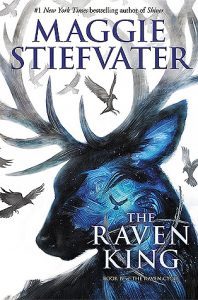
My goodness, can Maggie Steifvater write or what?
From The Dream Thieves:
“Whatever,” Ronan said. Which meant he’d do it.
Gansey looked at Blue. “Happy, Jane?”
Blue said, “Whatever.”
Which meant she was.
I love this snippet! This tidbit and a bit of the surrounding scene capture all three characters so well. Of course it’s almost impossible to pick out a bit because so many fragments of dialogue or thought or description are so perfect. Here’s another:
“Hello” [Mr. Gray] said cordially. “I didn’t mean to interrupt.”
First of all, the way he phrased it meant that he could see Noah, which not everyone could. Second of all, he was polite in a way that was unlike anything Blue had encountered before. Gansey was polite in a way that squashed the other party smaller. Adam was polite to reassure. And this man was polite in a keen, questioning sort of way. He was polite like tentacles were polite, testing the surface carefully, checking to see how it reacted to his presence.
Polite like tentacles are polite. I love it.
Okay, so the writing is just awesome. What about the story?
The characters
Brilliant.
Now, I will say, points of view proliferate in unexpected ways, which ordinarily I am not too keen on. But this worked pretty well for me in this long, rather leisurely paced fantasy in a way that it probably wouldn’t in a shorter, faster story.
Blue is the first point-of-view protagonist, but we also get Gansey’s pov, Adam’s, Ronan’s, Mr. Gray’s, and several less important characters, including many of the various bad guys.
Blue is definitely one of my favorite protagonists of the year. She’s in the middle of figuring out who she is, with the bravery and honesty and self-reflection that you see sometimes in teenagers. She’s proud and passionate and sometimes rather ferocious, and she tries really hard but sometimes she makes mistakes.
Gansey is fine, Adam is fine, but Ronan is one of my favorite supporting characters of all time. Talk about ferocity. He has trouble framing his thoughts in words; it’s easier for him to frame them with violence of one kind or another. Plus he has a really interesting character arc and role in the plot that I didn’t see coming in the first book even given the raven. I do kind of wonder how much of this story Maggie Stiefvater had framed out in the beginning. There are enough elements that appear kind of out of the blue (so to speak) that I’m guessing she did a fair bit of making it up as she went along. That is not an impression I got in The Scorpio Races at all, but it is in this admittedly much bigger story.
For example, Mr. Gray. I quite liked him, but then I always have been fond of hit men. At least, the right kind of hit men, which he is. But his appearance in the second book was definitely not foreshadowed in the first – nothing connected to him was foreshadowed either. I had the same impression with Henry: that Stiefvater threw him into the 4th book kind of on impulse and then made up his role. (I liked Henry very much, but he did seem kind of like a random element added on impulse and then given stuff to do.)
Well, the series all hangs together well enough, so if Stiefvater hadn’t quite settled the major events in her mind ahead of time, she did a good job weaving everything together .
Lots of great family relationships in this series, too. Genetic families and otherwise. All the psychic women in Blue’s family – Maura and Persephone and Calla are the most important – and of course the Gansey-Ronan-Adam-Noah-Blue group, with Henry added rather suddenly midway through the last book. Good family relationships: Gansey’s family. Toxic family relationships, Adam’s parents.
The Plot
As I say, it seemed to me that various elements might have been added kind of on a whim and then integrated after the fact. This isn’t exactly a flaw – they are integrated, after all. Besides, it may not even be true; maybe this series was plotted out from the beginning despite how it seems to me.
Other comments about the overall reading experience:
The story itself is surprisingly simple: We have Gansey’s question to find Glendower, and various complications that arise from that quest, and various friends that help and obstacles that get in his way. We’re pretty clear on the fact that Gansey’s going to die, what with Blue’s vision at the beginning of the first book and the warning about killing her true love with a kiss and all. I, at least, never really felt that it was at all likely that Gansey would really, truly die and stay dead. If you’ve read this series, were you particularly nervous about that?
Each book is amazingly self-contained considering the overall continuation of the main story. Great job with that. There’s really no need to read all four books back-to-back because plenty of threads get tied off in satisfying ways for each of the first three volumes. I will say, the whole series is fairly dark and the 4th book in particular is pretty much horror. By the time you reach it, though, you’re so caught up in the story that I doubt you’ll mind, even if, like me, you’re not ordinarily all that fond of horror.
Quibbles:
So, all Gansey’s friends and allies help fulfil his quest and all the obstacles fall and . . . I don’t want to put a real spoiler in here, so I will just say that for me, one aspect of the climax did not really work all that well. I mean, it made sense given where the story needed to go, but it also felt like something of a letdown after such a long buildup. For me it didn’t even truly count as an unexpected plot twist; I could see that something had to go wrong with this element of the plot, so it was more a question of exactly how it would go wrong. Also, following that incident, the entire ending seemed to unfold rather briskly considering the leisurely pace of the entire series up to that point. Still, I don’t want to overemphasize this issue, because honestly the ending worked okay for me. Especially with the epilogue. I did rather miss Noah in the epilogue; or I suppose what I mean is, it seemed to me he ought to have been missed more by the other characters. But I do appreciate epilogues generally and this one was important to lend a sense of closure to the whole story.
A detail that bothered me more: I did not really care for Stiefvater’s decision to develop a relationship between Ronan and Adam. It seemed SO pat and handy. Blue falls in love with Gansey, and since there’s only one girl to three guys, that leaves two guys lonely. So hey! They can have their own relationship, problem solved. I could see the relationship more for Ronan than for Adam. There were hints of his feelings from the beginning. For Adam, much less so.
You know what would work for me in a YA novel? To see one character fall for someone and not have their feelings reciprocated. I believe that occasionally that awkward situation has been known to occur in real life. Especially to high-school-aged kids. In this case, that would have thrown the ball back in Adam’s court, and Blue’s, and Gansey’s. How would they deal with jealousy and feelings of exclusion? Well, no need to worry about it, because poof! The problem is lifted neatly out of the way by the hand of the author so everyone can live happily ever after.
Still, these are quibbles. I want to emphasize that this is a great series, with amazing writing and great characters and lots of wonderful elements. I personally think The Scorpio Races is the superior story, but that’s because I truly loved The Scorpio Races, not because this quadrilogy isn’t also really good.
Please Feel Free to Share:









October 18, 2016
…Revivifying isotopes, really?
Derek Lowe analyzes a new health scam:
… a small Florida company (“Vector Vitale”) seems to have picked up on this research, and is claiming that isotopic ratios vary between younger and older bodily tissues, as well as healthy and diseased samples. That’s certainly possible, although they provide no data, but they’re also (you saw this coming) saying that the key to health is getting your isotopic ratios back in balance. And guess what! They’re preparing to sell you stuff to do just that!
Yes, how nice of them. Reading through Lowe’s post, I see that this is far from the stupidest fake-science-based scam I’ve ever seen, but it’s pretty stupid. But what I find interesting is not the fake science of the scam, but the horrible writing:
From the time of Adam and Eve, we ignore the importance of isotope selectivity in food and medicine, and every single day we consume a poison-antidote mixture to be lucky enough to stay alive for a while.
Human cells are well equipped to distinguish between complex macromolecules; different ions of chemical elements but for some reasons lack mass-spectrometry functions, as it requires strong magnets or centrifuges.
Thus we see that if your science education is lacking, your grammar-foo should come to your rescue by allowing you to easily identify this kind of thing as a scam. No one who writes as badly as this can possibly be selling a worthwhile product.
Also interesting: when I read through the comments yesterday, not a single commenter had mentioned the terrible writing of the advertisement. For me it’s what POPPED out.
Please Feel Free to Share:









Jen Swann Downey (Ninja Lybrarian series), on censorship
Okay, also at KidLitCon, the MG writer Jen Swann Downey presented a really good talk on censorship (the theme of KidLitCon this year was Gatekeeping). This evidently fits her oeuvre because I gather the Lybrarians in her series use time travel to protect writers and artists all through history.
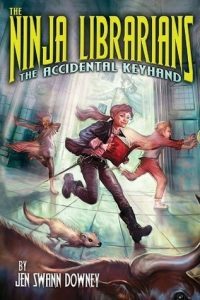
So, Downey drew on a talk she gave once to a lot of MG students, in which she did something clever:
First she showed slides of various writers and artists who have recently been silenced by their respective totalitarian governments and so on. She got the kids to react in horror and disgust to these incidents.
Then she said, Okay, now suppose that there’s a group in Your Town that is making a really good, persuasive case that dogs and cats ought to be outlawed within the borders of the town. Everyone who has a pet will have to get rid of it. If they can’t find another home for their puppy, they’ll have to have it euthanized . . . how many of you have a pet? Or want to have a pet? What do you think of this idea?
What if this group wants to put up a billboard and fliers promoting their agenda – no pets – should they be allowed to?
I bet you can see this coming! Free speech only for people we agree with! Bad opinions should be silenced.
Probably most of the kids eventually understood what they were doing, how they were switching sides in the free speech debate and why that’s wrong. Downey used this to illustrate the importance of basing your decisions on solid principles you’ve thought through properly beforehand: Without the principle as bedrock, it’s virtually impossible to make consistent decisions about issues involving morality and ethics.
Well, that’s certainly a useful talk to give these days, when the actual example kids see everywhere today in real life, especially on college campuses, is various groups trying their hardest to silence anyone who disagrees with them about anything and administrations going along out of lack of principle. Good for Downey, addressing the forces that can keep people silent and the importance of “gatekeeping with honor.”
I haven’t read any of her books, but I’m glad they’re out there and I’m thinking of giving one a try. She said she either has or will write one in which each of the young apprentice Lybrarians is assigned to protect a writer whose opinions they disagree with. That’s fantastic.
Please Feel Free to Share:









October 17, 2016
Well, yes, I do think they might be jumping the gun a little
It’s a bold claim. Two astronomers think they have spotted messages from not just one extraterrestrial civilisation, but 234 of them. The news has sparked a lively debate in the field as other astronomers think the claim is premature and are working fast to get to the bottom of the signals.
I would say that this sounds like a bold claim, yes.
In 2012, Ermanno Borra at Laval University in Quebec suggested that an extraterrestrial civilisation might use a laser as a means of interstellar communication. If the little green men simply flashed a laser toward the Earth like a strobe light, we would see periodic bursts of light hidden in the spectrum of their host star. They would be incredibly faint and rapid, but a mathematical analysis could uncover them….The overwhelming majority of those stars are in the same spectral class as the sun, which Borra says supports his hypothesis that this signature must be the result of extraterrestrial intelligent life. And with the data in hand, he thinks that 234 distinct civilisations are beaming pulses of the same periodicity (roughly 1.65 picoseconds) toward the Earth.
I’m all for optimistic interpretations of the data, especially if they are interesting, entertaining interpretations. But the notion that 234 different alien civilizations all decided to do this … at such times that we’re seeing all their signals now … sure they did. What else does anybody have to do with their time but flash lasers toward the Earth. You know, this is the kind of notion you should let your friends talk you down from. Before you go public.
For me the Skepticism Arrow is waaay over to the right:
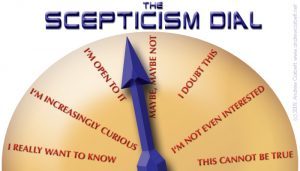
Please Feel Free to Share:









KidLitCon: dangerous for your TBR pile
So, it turns out that a) all the authors attending KidLitCon had books for sale; and b) publishers had sent heaps of ARCs to be given away. Makes sense, given the number of attendees who are bloggers (probably the majority) and the percentage of attendees who are avid readers (undoubtedly 100%).
Let’s just take a look at the selection of fourteen new books that wound up coming home with me, first the five I bought and then the nine ARCs.
1. I’ve never read anything by AS King. Frankly, these contemporary YA novels that deal with difficult topics would have been on the bottom of my list when I was a teenager, and are not what I specifically seek out today. Still, from SarahZ’s comment on a recent post (below), I see that King has been tending to infuse her more recent novels with dark fantasy (or horror?) elements. Anyway, I picked up a copy of Still Life with Tornado, King’s most recently released title.
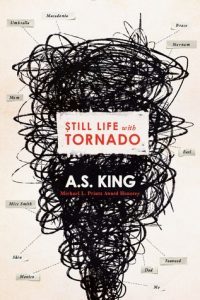
Here’s how it starts:
Nothing ever really happens.
Or, more accurately, nothing new ever really happens.
My art teacher, Miss Smith, once said that there is no such thing as an original idea. We all think we’re having original ideas, but we aren’t. “You’re stuck on repeat. I’m stuck on repeat. We’re all stuck on repeat.” That’s what she said. Then she flipped her hair back over her shoulder like what she said didn’t mean anything and told us to spend the rest of the class sorting through all the broken shit she gets people to donate so we can make art. She held up half of a vinyl record. “Every single thing we think is original is like this. Just pieces of something else.”
What do you think? I think I would go on with this just to see where it’s going. In fact, I did. I read the first three or four pages, by which time I was in danger of being sucked in, so I stopped for now because I’m reading something else.
2. The Truth Against the World by Sarah Jamila Stevenson. This is a ghost story, I gather. Or something like a ghost story. Maybe time travel? It’s about a girl named Olwen Nia Evans, whose family moves from San Francisco to Wales, which of course is where they have family roots. Olwen starts having dreams about Wales, dreams which don’t make sense. Then she meets a Welsh boy who’s met a ghost named Olwen Nia Evans…. So you see why I picked this one to try. Stevenson’s first book was contemporary and doesn’t sound like my kind of thing at all, but a spooky ghost story might work better for me. Here’s how it starts:
”Right over there, behind the church.” Gareth’s mother pointed. “You used to love rolling down the hill. Over and over until you got dizzy.” She laughed, the wind blowing her pale hair out of its ponytail and whipping it around.
Gareth glanced up from his phone. The hill looked a lot smaller than it seemed in his memory. It soared gently upward, its grassy flanks covered in purple and yellow wildflowers. The trail they were on meandered gently past it, looping around picturesque ruins and mysterious heaps of stones before ending in a rocky cliff overlooking the sea.
Shortly thereafter Gareth sees Olwen’s grave marker. I presume the ghost follows. I wouldn’t say this beginning particularly strikes me one way or another. I’m perfectly willing to go on for a bit, but I don’t feel like dropping everything to read this story.
3. I also picked up three MG military-historical novels, each featuring a guy and a dog. I hope I like them, since I got all three. They’re by a guy named C. Alexander London. The first features a Marine and a Lab in a recent setting – Afghanistan. The second features a US soldier during WWII who finds a German dog, a Doberman. The third features a Confederate soldier and a hound – the back cover refers to raccoons, but the dog on the cover is a Bloodhound, so we’ll see. I was caught by the differing historical periods and (of course) by the dogs. Dobermans are one of my favorite breeds, so I’ll show you a tiny snippet of that one, which is called Dog Tags: Prisoners of War:
“Hey, Rivera,” Goldsmith whispered in my ear. His breath frosted the air between us. “Looks like some kind of fairy tale out there in the woods, doesn’t it?”
Crunchy new snow clung to the tree trunks like white fur. I pressed my fingers against the ground in front of me and the snow crackled. I stood up to my shoulders in the icy foxhole. Goldsmith stood beside me, shivering and talking too much.
And then there’s an attack and stuff happens and Rivera gets separated from his unit and stumbles across this abandoned Doberman and we go on from there. I will probably read this and its companion stories pretty soon because they are very short.
4. Okay, now for the ARCs. Some are obviously left over ARCs from recent years, not for this year’s releases. Let me arrange them in publication order . . . all right, the first one I have here is from 2013, The Boy on the Bridge, a title that immediately creates disinterest for me because Teen Romance Novel is not generally what I’m looking for. However, we have onion domes in the background. Ooh.
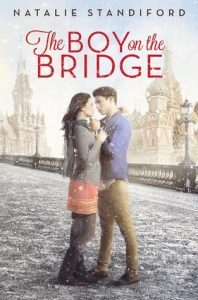
I’m a sucker for setting, so I turn the book over . . . laudatory quote from Libba Bray, interesting. Starred review from Kirkus, okay. Also from Publishers Weekly and School Library Journal. Still a teen romance novel, but now I’m interested enough to take a copy. Here’s how it starts:
Laura and her roommate Karen tramped along the frozen mud road that led through the university, past a wall with OGNEOPASNO! painted on it in huge red letters. An icy wind blew off the Neva River. It was January in Leningrad.
“Flammable,” Karen mumbled, reflexively translating. Somewhere nearby, invisible to the naked eye, there was, apparently, a fire hazard.
Not bad! I like the understated wit in that line. This story is set in 1982, incidentally.
5. Here’s one I grabbed without hesitation. Sarah Beth Durst, The Lost, published in 2014. I liked Durst’s Vessel, and I think I’ve read others by her as well. This one has one of those annoying covers where you have to pause and translate the weird design so you can read the title; also just not an appealing cover overall.
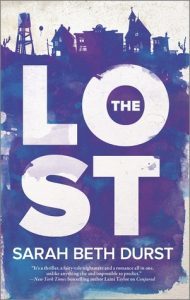
But the back cover copy sounds decidedly intriguing: “Once you arrive in Lost…well, it’s a place you really can’t leave. Not until you’re found.” Hmm. “Lauren is now trapped in the town where all lost things go – luggage, keys, dreams, lives.” Yeah, count me in for this one. Here’s the opening:
For the first hundred miles, I see only the road and my knuckles, skin tight across the bones, like my mother’s hands, as I clutch the steering wheel. For the second hundred miles, I read the highway signs without allowing the letters to compute in my brain. Exit numbers. Names of towns. Places that people call home, or not. After three hundred miles, I start to wonder what the hell I’m doing.
In front of me, the highway lies straight, a thick rope o asphalt that stretches to a pinprick on the horizon. On either side of the highway are barbed wire fences that hem in the few cows that wander through the scrub-brush desert. Cacti are clustered by the fence posts. Above, the sun has bleached the blue until the sun looks like fabric stretched so thin that it’s about to tear. There are zero clouds.
I should turn around.
Ooh, catchy. I hope the rest of the book lives up to that beginning, because I love it so far.
6. Another 2014 release, The Winter Guest by Pam Jenoff. A WWII setting, rural Poland during the Nazi occupation. Older kids trying to raise younger siblings. A stranded Allied (and Jewish) paratrooper. I like it so far. The back cover copy does finish with “… culminating in a singular act of betrayal that endangers them all…” Hmm. I detest most plot twists that involve betrayal. I’m willing to give this one a try, but that one line on the back does count against it. The book will tend to shuffle downward in the TBR pile. I guess it’s hard to know what will particularly catch readers or turn them away, but fwiw, do not stress betrayal plot twists if you’re trying to get me to read a book.
Anyway, I’m skipping the prologue right now (it’s a frame story that takes place much later, apparently). Here’s how chapter one starts:
The low rumbling did not rouse Helena from her sleep. She had been dreaming of makowiec, the poppy seed rolls Mama used to make, thick and warm with a dusting of sugar. So when the noise grew louder, intruding on her dream and causing her hands to tremble, she clung tighter to the bread, drawing it hurriedly to her mouth. But before she could take a bite, a crash rattled the house and a dish in the kitchen fell and shattered.
Ah, starting right in with the plane crash, I see. Yes, that sounds like a good choice. I expect we’ll get into the real story right away as soon as we’re past the (short) prologue.
7. Last ARC from before this year; I like this title, and I like the cover and the design. Like Water on Stone by Dana Walrath, which came out late in 2014.
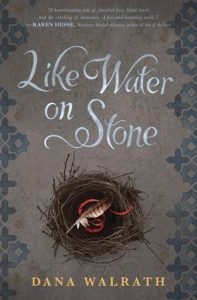
I read one line from the back cover (“It is 1914 and the Ottoman Empires is crumbling into violence”) and picked it up. The setting is grim but interesting: this story takes place against the backdrop of the Armenian genocide. Plus the story seems to have fantasy elements, or elements that may be ambiguously fantastic – the eagle’s feather and the eagle.
Now, opening the book for the first time, I find something unexpected: this story is told in verse form. My first impression was that it opened with a poem, but no. The whole thing is told as a series of poems. I’ve never seen a story like that before. I mean, other than classic epic poetry. What a different kind of thing. I’m dying to know this book’s publication story. It came out from a Random House imprint. I wonder how hard it was to place, what its critical reception was, how it sold. As a young reader . . . actually I might have been attracted to a poem in book form.
Let’s take a look:
Three young ones,
One black pot,
A single quill,
And a tuft of red wool
are enough to start
a new life
in a new land.
I know this is true
because I saw it.
We track our quills
when they fall.
Always.
This is the eagle speaking. Well, not sure when I’ll feel like reading epic poetry about the Armenian genocide. Still, I’m glad I picked this up.
8. Moving on to ARCs from this year, here is Everland by Wendy Spinale. It’s out – it came out this spring. Nice play on “Neverland,” and the cover is playing around with the Tinkerbell image, I’m pretty sure. “The only way to grow up is to survive.” Well, that’s generally the case, of course. Still, the tagline is also playing off Peter Pan. On the back it just says, “To die will be an awfully big adventure.” Hmm.
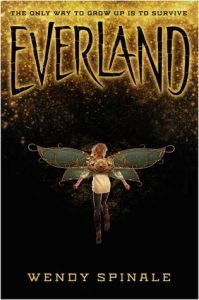
Okay, looking at the inside flap, I see this is a kind of post-apocalyptic setting. “London has been destroyed in a blitz of bombs and disease. The only ones to survive the destruction and the outbreak of a deadly virus are children.” The conception is quite something: Captain Hook is a Nazi, Pete is the leader of a gang of boys, Bella is a sharpshooter, and the protagonist, Gwen, is determined to rescue her sister from Hook’s clutches before he can use her for experiments having to do with that virus. Here’s Gwen in the opening chapter:
Outside my window, plumes of gray smoke and steam rise from the decimated city into the polluted midnight sky. There they linger like ghosts of those who once walked the streets of London before the arrival of the Marauders. Pirates. I briefly wonder what life was like before the German monarch’s reign began and the world was without steam power.
Well, well. Not exactly Nazis, then. This history is even more alternate than I thought. Looks like quite an addition to the Peter Pan oeuvre.
9. Okay, this one — The Call by Peadar O’Guillin – looked possibly too dark for me given the cover. Horror, dark fantasy, hard to tell. But the back cover is catchy. “3 Minutes. You wake up alone in a horrible land. A horn sounds. The Call has begun. 2 Minutes. The sidhe are close. They’re the most beautiful and terrible people you’ve ever seen. And they’ve seen you. 1 Minute. Nessa will be Called soon. No one thinks she has any chance to survive. But she’s going to prove them wrong.”
What do you think? Maybe a Hunger Games kind of thing. But with sidhe.
This book came out this August. Here’s how it starts:
On her tenth birthday Nessa overhears an argument in her parents’ bedroom. She knows nothing about the Three Minutes yet. How could she? The whole of society is working to keep its children innocent. She plays with dolls. She believes the lies about her brother, and when her parents tuck her into bed at night – her grinning dad, her fussy mam – they show her only love.
But now, with ten candles on a cake in the kitchen behind her, that’s all supposed to change.
Dad can’t know his daughter is right outside the door and yet he whispers. “We don’t need to tell her,” he says. “She . . . she isn’t able to run anyway. She’s a special case. We could give her a few more years to be our baby.”
Interesting! Overall I’m glad I picked this up, though present tense is not my favorite. I don’t suppose any of you have read it? I’m wondering just where it falls in the spectrum of horror/dark fantasy. I may read reviews first. Or I may just go into it cold and see where it goes.
10. Now we finally get to the ARCs for books that aren’t out yet – though nearly. This one is coming out a week before my MOUNTAIN OF KEPT MEMORY, which I’m sure you’ve all pre-ordered, right?
Anyway, this is Hotel Ruby by Suzanne Young. It’s the one that has my favorite cover of all these books, I think.
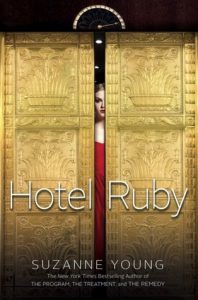
It’s a haunted hotel story, I think. Or maybe this is another glimpse of a perhaps creepy Faerie? A bit hard to tell.
The treetops curve above the road like an archway, blotting out the moon and stars. We’ve been driving through these woods for close to an hour, and our car headlights shine only a short distance in the thick fog. I glance into the backseat to check my older brother’s current state of annoyance, but Daniel hasn’t spoken to m since the rest stop near Vegas. He stiffens, aggressively ignoring me when he turns to face the dark outside the window.
“If we stay on this road,” my father says, “I think there’s a shortcut through the mountains. I remember taking it one time with your mother.”
Ah, shortcuts. Never a good idea when you’re possibly in a horror novel.
I see this is yet another present-tense story. Some authors can make this work, but I do prefer almost every other possible style to first-person-present-tense. I know it’s supposed to make the story feel more immediate. To me, until I adjust to it, this style just adds a layer of artifice on top of what may be a perfectly good story.
11. Out at the end of November, Bright Smoke Cold Fire by Rosamund Hodge. I didn’t look at this at all, just picked it up because I recognized the author’s name. I didn’t love Cruel Beauty, but I liked it quite a bit. Now let’s take a look at this new novel …
Ah ha. This is unexpected. A Romeo and Juliet retelling. I wonder if it ends with a pile of bodies or whether Hodge changes the ending? The complicated back cover copy leaves me with lots of questions. Not a play-by-play retelling, that’s for sure:
The heirs of the city’s most powerful—and warring—families, Mahyanai Romeo and Juliet Catresou share a love deeper than duty, honor, even life itself. But the magic laid on Juliet at birth compels her to punish the enemies of her clan—and Romeo has just killed her cousin Tybalt. Which means he must die.
Paris Catresou has always wanted to serve his family by guarding Juliet. But when his ward tries to escape her fate, magic goes terribly wrong—killing her and leaving Paris bound to Romeo. If he wants to discover the truth of what happened, Paris must delve deep into the city, ally with his worst enemy . . . and perhaps turn against his own clan.
Mahyanai Runajo just wants to protect her city—but she’s the only one who believes it’s in peril. In her desperate hunt for information, she accidentally pulls Juliet from the mouth of death—and finds herself bound to the bitter, angry girl. Runajo quickly discovers Juliet might be the one person who can help her recover the secret to saving Viyara.
Interesting, yes? Here’s how it starts:
If he does not come soon, she may not have the heart to kill him.
For an hour now she has sat at the foot of her bed, gripping her sword in its crimson scabbard. Over and over she whispers, “I am the sword of the Catresou. I was born to avenge the blood of my people.”
But her traitor throat aches and her coward eyes sting. Once upon a time she believed she was only a sword. Now she fears she is only a girl.
Plenty of craft in this opening. I’m not a great fan of Romeo and Juliet (I greatly prefer the comedies), and angsty romance doesn’t do much for me. Still, this looks like a really intriguing book.
12. Okay, this is the only ARC that looks obviously like a MG story. It’s also the ARC with the longest lead time: it’s not due out till January 2017. It’s called Me and Marvin Gardens, it’s by Amy Sarig King . . . oh ho. Amy Sarig, hmm? I bet . . . yes, checking, I see this is indeed A S King, author of those contemporary YAs such as Still Life with Tornado, the first book in this post. Well, how very appropriate to end with this MG by the same author. Totally did not intend that, but I certainly would have set it up that way if I’d realized.
Well, I picked it up off the freebie table not because I recognized the author’s name, but because the back cover says: “The track was part hoof and part paw. It was part dog and part pig. It made no sense, this track.” It goes on but that was when I picked it up and tucked it on the pile of books I was taking home. Looks like a story about a boy and his . . . weird animal.
Here’s how it actually starts:
There were mosquitoes. There were always mosquitoes at Devlin Creek this time of year. Every time I went inside I had twenty more bites than I had the last time, and Mom made a noise as if it was my fault. As if I created mosquitoes.
There was a bloody nose. It wasn’t my first. I didn’t have any tissues or napkins and I was in a good t-shirt, so I lay on my front with my head out over the bank and let the blood drip into the creek. I wondered if the fish would smell it or taste it or breath it. I knew by then that nosebleeds only lasted so long. I’d learned not to pinch my nose or tilt my head back six months ago. You just had to let it bleed until it was done.
Most people get nosebleeds because something happened. Like maybe they got hit with a baseball or walked into a door. I got nosebleeds for no reason.
Or there was a reason.
I just didn’t like to talk about it.
Okay, intriguing. Reading the rest of the page, I’m guessing this kid has gotten off on the wrong foot with some other boys and got this nosebleed via fighting. This beginning is fine, but without the reference to weird tracks on the back cover I’m not sure I would bother going on. Also, this looks like it’s going to have a Conserve The Environment Message overt enough to whap the reader upside the head. Still, AS King may well be a good enough writer to pull this story off without being too overt. Anyway, I will definitely read this one at the same time as the Tornado one; it’ll be fascinating to compare them.
Okay, that’s it (and this post is certainly long enough!). Any of the above stand out for you in a good way or a bad way? For me the two that are trying the hardest to draw me in are #5, The Lost by Sarah Beth Durst; and #8, Everland by Wendy Spinale. And, somewhat to my surprise, maybe #9, The Call by Peadar O’Guillin.
None of the books on this stack look like I made a mistake to pick them up (I tried to only take home books I had a good chance of liking). I have to say, my print TBR shelves are definitely overflowing, though. I may need to put away my Kindle for about a year (this won’t actually happen) and make a solid attempt to whittle the books on the print shelves back to the point all the books fit on the actual shelves. Right now I have three stacks of books on the floor in addition to the shelves.
Please Feel Free to Share:









October 15, 2016
KidLitCon: A. S. King, on literacy
So, Amy S. King gave the keynote address at KidLitCon yesterday, an entertaining and at times moving talk that drew on memories of her own teen years and on her work with adult literacy in Ireland. I took notes, but certainly not enough to give a play-by-play recap, not that such a thing would make riveting reading anyway, probably.
King grew up in the midst of cornfields, and it sounds like her parents went to some trouble to create a safe bubble for her childhood, which is great, but of course didn’t spare her from all the typical issues that teens have to deal with — feelings of not fitting in and all the rest. She described how important contemporary YA novels were to her while she tried to figure out her own life — Pardon Me You’re Stepping on My Eyeball by Zindel, the rest of Zindel’s books.
Anyway, here are some of King’s comments:
Some of what we see as adult literacy problems is created in people who enjoyed reading as children but were turned off reading by the books they were assigned to read as teenagers. They stop reading at that point and lose some of their reading skills.
Teenagers don’t have time to read the books they care about because they’re so busy trying to figure out why they should care about the books that are assigned.
English teachers dismiss the contemporary novels that truly speak to teens in favor of classics that teens can’t relate to (such as The Scarlet Letter).
King wanted to write books that would help parents understand teens and teens understand parents — she wrote this comment to herself when she was fourteen. But her books were “too weird” and she had trouble finding interested publishers at first.
So.
I remember Zindel’s books — I mean, I remember that they existed. I was so totally uninterested in contemporary at that time, I never read any of Zindel’s books myself and frankly feel no impulse to read them now. But for King, they were instrumental in shaping the kinds of books she writes today. I suspect this is true of most of us — that whatever novels we fell in love with as teenagers “set” our literary taste forever. (For me it was Patricia McKillip and Robin McKinley and other fantasy authors.)
It’s interesting to me to hear from an author to whom contemporary YA was THE crucial influence. As you know if you’ve been reading this blog for any length of time, I too found the assigned books in HS unappealing, but I wasn’t looking for stories that echoed contemporary life and everyday concerns. Definitely not! I went straight for secondary world fantasy, plus SF, historicals, and mysteries.
Two thoughts: a) fortunately there are stories to suit all tastes, especially now with the explosion of YA; and b) But on the other hand, I’m actually quite glad YA didn’t exist as a category when I was growing up, because most of the wide range of stories at the time was published as adult, including Patricia McKillip and Robin McKinley. I continue to worry that YA is doing a disservice to teen readers by pushing them away from so-called adult novels that would actually suit them perfectly. Though YA is soooo huge now that this may be less of a problem (except for its constant message that teens shouldn’t be able to identify with older or younger protagonists, a message I really, really hate).
Anyway, I did pick up A S King’s latest, Still Life with Tornado. I do read some contemporary these days, though this one sounds a bit weird:
Sixteen-year-old Sarah can’t draw. This is a problem, because as long as she can remember, she has “done the art.” She thinks she’s having an existential crisis. And she might be right; she does keep running into past and future versions of herself as she wanders the urban ruins of Philadelphia. Or maybe she’s finally waking up to the tornado that is her family, the tornado that six years ago sent her once-beloved older brother flying across the country for a reason she can’t quite recall. After decades of staying together “for the kids” and building a family on a foundation of lies and domestic violence, Sarah’s parents have reached the end. Now Sarah must come to grips with years spent sleepwalking in the ruins of their toxic marriage. As Sarah herself often observes, nothing about her pain is remotely original—and yet it still hurts.
As a fantasy reader, I have trouble guessing whether this “running into past and future versions of herself” is meant to be taken literally. We’ll see!
Please Feel Free to Share:












